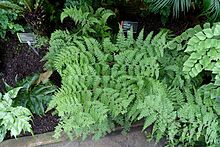Hypodematiaceae
| Hypodematiaceae | |
|---|---|

| |
| Leucostegia pallida | |
| Scientific classification | |
| Kingdom: | Plantae |
| Clade: | Tracheophytes |
| Division: | Polypodiophyta |
| Class: | Polypodiopsida |
| Order: | Polypodiales |
| Suborder: | Polypodiineae |
| Family: | Hypodematiaceae Ching[1] |
| Genera[1] | |
Hypodematiaceae is a family of ferns in the order Polypodiales. In the Pteridophyte Phylogeny Group classification of 2016 (PPG I), the family is placed in the suborder Polypodiineae.[1] Alternatively, it may be treated as the subfamily Hypodematioideae of a very broadly defined family Polypodiaceae sensu lato.[2] The family consists of two, or in some versions three, small genera.[1]
Taxonomy
[edit]Hypodematiaceae was erected by Ren-Chang Ching in 1975,[3][4] but was not subsequently accepted by many authors. It was not accepted in a classification of ferns that was published in 2006.[5] In that paper, the genera Hypodematium, Leucostegia, and Didymochlaena were provisionally assigned to Dryopteridaceae, with the authors expressing some doubt about whether they really belonged there. In two molecular phylogenetic studies published in 2007, the clade that was tentatively called eupolypods I was resolved as a tritomy consisting of Didymochlaena, Hypodematiaceae sensu stricto, and the rest of eupolypods I.[6][7]
Phylogeny
[edit]The following cladogram for the suborder Polypodiineae (eupolypods I), based on the consensus cladogram in the Pteridophyte Phylogeny Group classification of 2016 (PPG I),[1] shows a likely phylogenetic relationship between Hypodematiaceae and the other families of the clade.
| Polypodiineae (eupolypods I) | |
Genera
[edit]The Pteridophyte Phylogeny Group classification (PPG I) includes two genera:[1]
- Hypodematium Kunze – about 20 species
- Leucostegia C.Presl – two species
Didymochlaena has been placed in this family as well, but in PPG I, it is placed in its own family, Didymochlaenaceae.[1]
References
[edit]- ^ a b c d e f g PPG I (2016). "A community-derived classification for extant lycophytes and ferns". Journal of Systematics and Evolution. 54 (6): 563–603. doi:10.1111/jse.12229.
- ^ Christenhusz, Maarten J.M. & Chase, Mark W. (2014). "Trends and concepts in fern classification". Annals of Botany. 113 (9): 571–594. doi:10.1093/aob/mct299. PMC 3936591. PMID 24532607.
- ^ Ren-Chang Ching. 1975. Acta Phytotaxonomica Sinica 13(1):96.
- ^ James L. Reveal. 2008 onward. "A Checklist of Family and Suprafamilial Names for Extant Vascular Plants." At: Home page of James L. Reveal and C. Rose Broome. (see External links below).
- ^ Alan R. Smith, Kathleen M. Pryer, Eric Schuettpelz, Petra Korall, Harald Schneider, and Paul G. Wolf. 2006. "A classification for extant ferns". Taxon 55(3):705–731 doi:10.2307/25065646 (See External links below)
- ^ Eric Schuettpelz and Kathleen M. Pryer. 2007. "Fern phylogeny inferred from 400 leptosporangiate species and 3 plastid genes". Taxon 56(4):1037-1050.
- ^ Hong-Mei Liu, Xian-Chun Zhang, Wei Wang, Yin-Long Qiu, and Zhi-Duan Chen. 2007. "Molecular Phylogeny of the Fern Family Dryopteridaceae inferred from Chloroplast rbcL and atpB Genes". International Journal of Plant Sciences 168(9):1311-1323. doi:10.1086/521710
